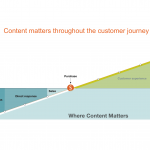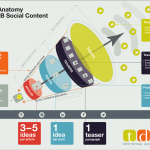Does your content do most of the selling for your company? It should. But if it doesn’t, your problem may be rooted in not having a content strategy that mirrors an effective sales funnel. In my upcoming session for the Online Marketing Institute’s “B2B Digital Marketing Essentials for 2014” series of seminars taking place tomorrow, January 28, 2014, I’ll be explaining why competitive marketers need to understand the importance of the B2B content funnel in accelerating the sales cycle.
This session is based on best practices that TDA Group uses on behalf of some of the world’s biggest and most demanding high-technology brands.
My talk describes how and why a B2B content funnel is essential for selling to discerning audiences. Here are four takeaways:
1. Content matters throughout the entire B2B buyer’s journey.
Sales needs to focus on closing, not explaining.
Not too long ago, marketing was typically responsible for only the beginning stages of the buyer’s journey: generating interest, awareness, and leads in the form of names, titles, and phone numbers. Salespeople handled much of the rest. Today, this model has changed dramatically. Potential customers are self-educated about products and services, define their own requirements, and contact salespeople only after they’ve already made much of their decisions.
Since content fosters understanding, it is crucial—especially in markets characterized by complex product offerings.
2. Recognize that the funnel is also shaped like a megaphone.
Imagine a picture of a traditional sales funnel: wide at the top where you find new leads, narrower in the middle where consideration occurs, and tightest at the bottom where deals close. Now look at the bottom of the funnel and imagine it as a mouthpiece where thought leadership content is spoken and then grows louder, changing in tone and volume as it resonates outward to increasingly larger audiences.
Tweets, teasers, and abstracts represent the shorter-form content needed for the top end of the megaphone to hook increasingly distracted audiences and draw them into your content stream. These short, concise bursts of content pique interest and induce curiosity, and help ensure new leads progress, find interest in your thought leadership content, and become ready and willing to hear it. Tweets and teasers correspond with nascent brand awareness, and lead to posts and abstracts, which lead to interest in what you have to offer—and compel customers toward deeper engagement.
Tweets lead to paragraphs, paragraphs lead to posts, and posts lead to articles and white papers. As the funnel narrows, articles, case studies, and brochures integrate with direct response and conversations. Ultimately, thought leadership content generates serious consideration and purchase decisions. Ideally, all of this content is premeditated and coordinated, and supports an effective messaging theme.
3. Drive all forms of content with thought leadership.
Effective B2B social content starts and ends with thought leadership. All those tweets, posts, and articles must have a foundation to be meaningful. Found in your meatiest content such as white papers and bylined articles, thought leadership is truly useful and hard to fake. To produce it, you must have genuine subject-matter experts in tune with the challenges that actual customers face—subject-matter experts equipped with thoughtful opinions about how to best address those very real customer challenges.
Since that kind of expertise is rarer than it should be, prospects and customers appreciate it when they find it. When developing thought leadership content, focus on three crucial qualities:
• Expert. Be genuine and deliver real value—not invented or phony—and certainly not arrogance masquerading as expertise.
• Original. Make the content uniquely yours. Represent the distinctive and timely perspective your brand has on the industry, marketplace, or other topic at hand.
• Comprehensive. Cover your bases frankly and honestly. You know those questions your sales team is hoping don’t get asked? Your prospects will inevitably ask them, so don’t just ignore them.
4. Understand that your goal is to sell.
The goal is sales, sales, sales. Leads and market interest are critical for getting the customer to choose your product or service, but unless your content leads prospects to the point of purchase, something’s probably broken, missing, or muted.
Discover more tactics about the B2B content funnel on Jan 28th.
Join me at the “B2B Digital Marketing Essentials for 2014” virtual event. You’ll get more details about the fundamentals of the B2B content funnel, and discover how to implement it in your own marketing practice.

